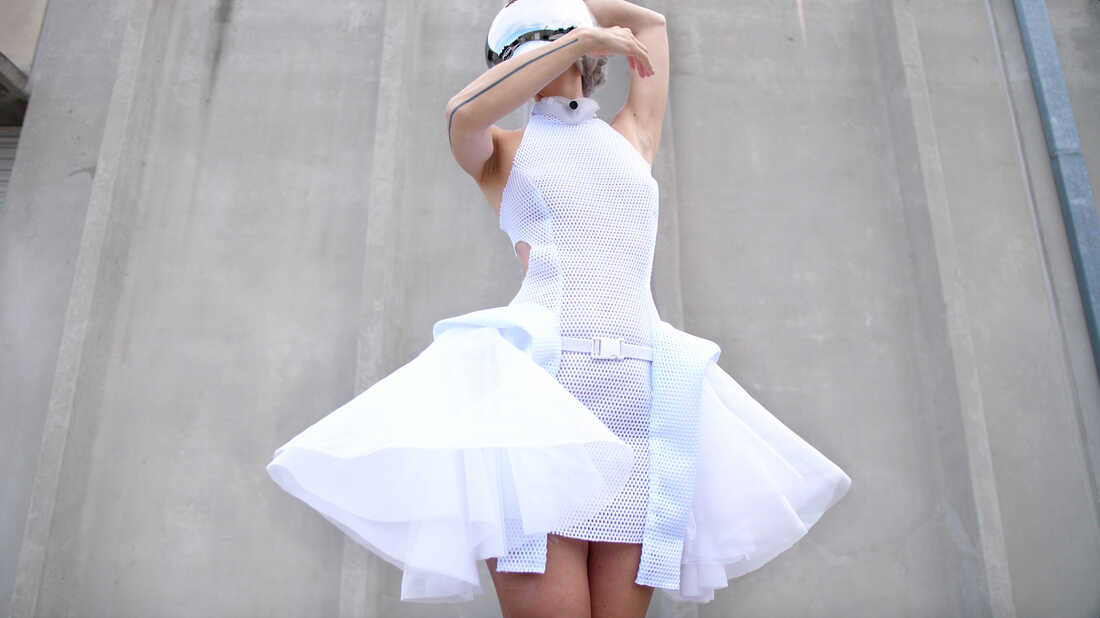
The "Pangolin Dress" by Anouk Wipprecht. Yanni de Melo
Would you wear a dress that signals to people that they're standing too close to you?
Or how about a shirt that changes color when it senses a change in your mood?
Those are actual creations Dutch fashion designer and engineer Anouk Wipprecht has been working on for 20 years.
Her distinctive 'fashion tech' designs combine couture, interactive technology and artificial intelligence.
"So, on a day I am coding and designing, I am sewing and anything and everything that has to do with the body and technology and electronics," Wipprecht told Morning Edition.
How it started
Growing up in the Netherlands, she was influenced by American culture after watching MTV in the 90s.
"I was really fascinated by the notion that the people really express themselves through basically the things that they wear," she remembers.
When she was 14 years old, she started making women's clothing. By 17, while in fashion school, she started to feel a bit unfulfilled.
"I started to notice that the garments that I was creating were 'analog'. They were not doing anything. They were not sensory. They were not changing. "
So, she decided to create something she'd never seen. She began designing with microcontrollers, robotics, and small motors.
"And that's really made it complete for me."
How it's going

Anouk Wipprecht modeling her "Spider Dress" which with the help of long, spider-like tentacles reacts to movement. Jeff Cacossa
One of her most notable designs is aptly named "The Spider Dress."
On the shoulders of the dress, there are long spider-like tentacles that move with the help of sensors. "It measures the intimate space, the personal space, the social space and the public space of the wearer," she explains.
"Whenever somebody comes into the personal space, it's attacking because of the mechanical failure sense that the dress has."
That 3D printed design, which now has several iterations, has been worn by models and displayed around the U.S and the world, including China, Russia and Amsterdam.
When COVID hit, Wipprecht borrowed some of the aesthetic from her Spider creation and designed the "Proximity Dress," which she hoped would help people better understand how to socially distance.

The "Proximity Dress" which expands to reinforce social distancing when someone gets too close. Jeff Cacossa
This white dress looks unassuming, but uses ultrasonic range finders that allow it to puff up or inflate when someone gets near. Wipprecht wore it at a park in Miami where she lives.
The interactive outfit, which she called a "very elegant way to use sensors," helped people get the point — to give each other space.
Courtesy of Anouk Wipprecht
Her designs are conversation starters. And could even help people discuss tough topics.
Right now, she's being commissioned to work on several wearable prototypes that visually measure things like anxiety and depression.
"We live in a time and age that's sort of the negative emotions start to take over, Wipprecht explains. "A lot of people start getting into more depressive mode, maybe not wanting to speak about it and all of that stuff. So, it might even create a situation that these things become more discussable."
This story originally appeared on the Morning Edition live blog.
"social" - Google News
August 05, 2021 at 09:56PM
https://ift.tt/2WTWjTD
To Inspire Social Distancing, The 'Proximity Dress' Merges Computers And Couture - NPR
"social" - Google News
https://ift.tt/38fmaXp
https://ift.tt/2WhuDnP
Bagikan Berita Ini















0 Response to "To Inspire Social Distancing, The 'Proximity Dress' Merges Computers And Couture - NPR"
Post a Comment